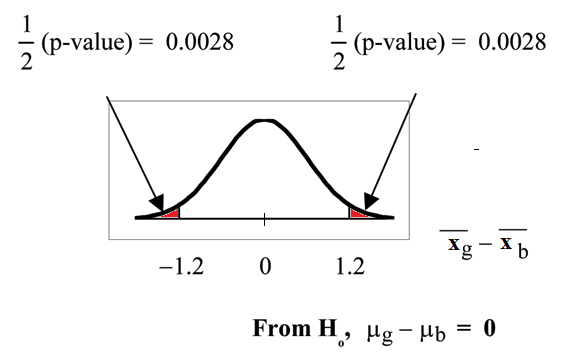The population standard deviations are not known.
Let g be the subscript for girls and b be the subscript for boys. Then, μg is the population
mean for girls and μb is the population mean for boys.
This is a test of two independent groups, two population means.
Random variable:
 = difference in the sample mean amount of time girls and boys play sports each day.
= difference in the sample mean amount of time girls and boys play sports each day.
Ho:

Ha:

The words "the same" tell you
Ho has an "=". Since there are
no other words to indicate
Ha,
then assume "is different."
This is a two-tailed test.
Distribution for the test:
Use
tdf where
df
is calculated using the
df
formula for independent groups, two
population means. Using a calculator,
df
is approximately 18.8462. Do not pool
the variances.
Calculate the p-value using a student's-t distribution: p-value = 0.0054
Graph:

sb
=
1
So,

Half the p-value is
below -1.2 and
half is above 1.2.
Make a decision: Since α> p-value, reject
Ho.
This means you reject
μg
=
μb. The means are different.
Conclusion: At the 5% level of significance, the sample data show there is sufficient
evidence to conclude that the mean number of hours that girls and boys aged 7
through 11 play sports per day is different (mean number of hours boys aged 7 through 11 play sports per day is greater than the mean number of hours played by girls OR the mean number of hours girls aged 7 through 11 play sports per day is greater than the mean number of hours played by boys).
TI-83+ and TI-84: Press STAT. Arrow over to TESTS and press
4:2-SampTTest. Arrow over to Stats and press ENTER. Arrow down
and enter 2 for the first sample mean,

for Sx1, 9 for n1, 3.2 for the
second sample mean, 1 for Sx2, and 16 for n2. Arrow down to μ1: and
arrow to does not equal μ2. Press ENTER. Arrow down to Pooled: and
No. Press ENTER. Arrow down to Calculate and press ENTER. The
p-value is p = 0.0054, the dfs are approximately 18.8462, and the test
statistic is -3.14. Do the procedure again but instead of Calculate do Draw.





















